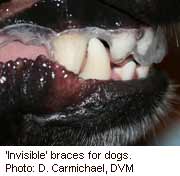
THURSDAY, Dec. 23 (HealthDay News) — Cynthia Duggan was so surprised to learn her Australian shepherd puppy, Molly, needed dental braces that she hesitated to give her veterinarian the OK.
But after mulling over the $1,000 orthodontic procedure with her husband, the couple finally decided it would be money well spent.
“She’s an incredible dog,” said Duggan of the 9-month-old puppy, already showing potential as a herding champion. “We felt like she deserved it.”
The braces weren’t for appearances, though. Unlike braces for humans, who often endure an ugly mouth full of metal in pursuit of a perfect smile, canine braces aren’t applied for cosmetic reasons. Instead these “oral appliances” alleviate pain or discomfort from an abnormal bite, usually caused by a few crooked teeth.
In Molly’s case, a large upper tooth protruded like an elephant’s tusk, preventing the pup from comfortably closing her tiny mouth, said Dr. Larry Baker, of Northgate Veterinary Dentistry and Oral Surgery in Decatur, Ill.
To correct the problem, Baker attached a rubber band, called a power chain, to the wayward tooth, successfully pulling it back into place in just three weeks.
“She tolerated it well,” said Duggan. “We were pretty thrilled with the way it turned out.”
Baker has used metal braces on dogs, like the ones teenagers wear, but instead prefers to create his own from the material used to fill cavities in people.
“My dog braces do not typically look like human braces,” explained Baker, one of only about 125 board-certified veterinary dentists in the world. “Yet, they accomplish the same result: moving teeth.”
Dr. Daniel Carmichael, a board-certified veterinary dentist at the Animal Medical Center in New York City, said the critical ages for detecting orthodontic problems — only some of which are corrected by braces — are during the first several months of a dog’s life. A veterinarian should check the “baby teeth” at around eight to 10 weeks of age, he said, and then again around six to eight months of age when the permanent adult teeth are present.
Most orthodontic problems that crop up in dogs are hereditary, he said. Breeds predisposed to such dental issues include Irish Setters, Standard Poodles, Shelties and Labrador Retrievers.
“Not all dogs are entitled to the perfect bite, but all dogs are entitled to a healthy, functional bite,” said Carmichael.
Braces realign an abnormal bite to prevent problems, he said, such as difficulty eating, closing the mouth, or trauma to the teeth and gums.
Invisible braces — a transparent, removable alignment originally developed for people — are the latest tool in veterinary orthodontics. The primary benefit is that dogs only need to be sedated one time to create a mold of the teeth. Once the clear acrylic aligners are worn by the dog for as many hours a day as possible, he said, correction occurs in about four to six weeks, which is much faster than in human patients.
He said the condition most responsive to invisible braces is base narrow canines, or “linguoversion,” where the lower teeth point inward, injuring the roof of the mouth.
Carmichael only sees one or two orthodontic cases a month that require some form of treatment. However, Baker of Northgate Veterinary Dentistry sees much more, about one dog a week (and occasionally cats) at his Midwest practice. Not all orthodontic cases, though, require braces to correct a bad bite. Other treatment options include extraction, surgery and tooth extensions.
Such dental problems, of course, are not something the average dog owner has to contend with. “The chances are, they won’t be faced with the prospect of having to get their dog braces,” said Carmichael.
More information
There’s more on pet dental health at the American Veterinary Medical Association.

